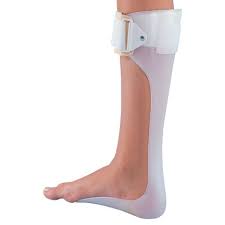Pediatric Orthotics – Why the Heel?
by Kids Place Central Pediatric Physical Therapists
As pediatric physical therapists, we often recommend a child be evaluated and fit for a pair of ankle-foot orthotics or AFOs.
 AFOs are plastic devices created by a certified orthoptist, custom made to control certain parts of an extremity, guide specific movements, or immobilize a joint. Over the years, we have come up with some pretty creative names for these devices – moonboots, super shoes, and armor, to name a few. An AFO looks like a boot that goes from the base of your toes up along the back of the leg, below the knee. Some AFOs have plastic shells on the front while others are secured with Velcro.
AFOs are plastic devices created by a certified orthoptist, custom made to control certain parts of an extremity, guide specific movements, or immobilize a joint. Over the years, we have come up with some pretty creative names for these devices – moonboots, super shoes, and armor, to name a few. An AFO looks like a boot that goes from the base of your toes up along the back of the leg, below the knee. Some AFOs have plastic shells on the front while others are secured with Velcro.
When looking at the way a child walks, we focus on the way the lower part of their leg – the shank – is moving during the gait cycle.
During typical gait, the shank moves from a reclined position to an inclined position at certain points. When the shank is “reclined” it creates a diagonal line from the ankle to the knee pointing backwards. When the shank is “inclined” it creates a diagonal line from the ankle to the knee pointing forward.
During atypical gait, the movements of the shank are interrupted or non-existent. Often, we describe a person’s gait pattern with excessive inclination (someone who always walks with their legs bent) or insufficient inclination (someone who snaps their knee back or walks on their toes).
Orthotics are used to promote typical shank movements by allowing for proper gait kinematics (motion without regard to what is causing it) and kinetics (the forces and torques that cause motion). One of the best ways to promote typical movement is by maintaining the shank in a slightly inclined position in the orthotic, which is achieved by “wedging” or putting a heel on the bottom of the AFO. Through a process of “tuning” the AFO by an orthoptist, small adjustments will be made to the device to achieve the proper angle of inclination with the heel. Depending on the current pattern, this ranges from ~10-17 degrees inclined from vertical.
This position puts the rest of the lower extremity in a position to increase firing of muscles that are probably not firing during the child’s current gait pattern, which allows the brain to learn when to turn on the muscles (patterning), strengthens certain muscles, and stretches out others. With regular use of these AFOs in both standing and walking activities, we see incredible changes in children’s endurance, strength, standing tolerance, and range of motion as well as see improvements in how the child is walking.
One of the most common concerns from caregivers is the difficulty of getting the heel into a shoe. Your orthoptist should help with some guidelines of shoes that are best but here are a few tips:
- Use regular supportive tennis shoes – no need for high-tops since the AFOs are plastic and support the ankle
- Go 1 size larger and wider
- When putting the shoe on, try to pull the tongue open as far as possible to slip the AFO into the shoe
- Using a shoehorn will make it easier, especially when the shoe is extra stiff before it’s broken in






